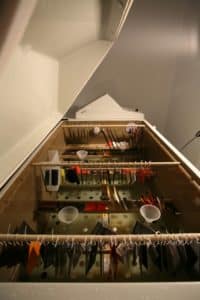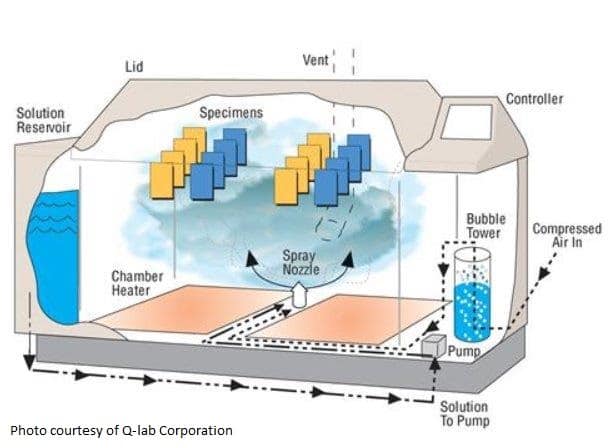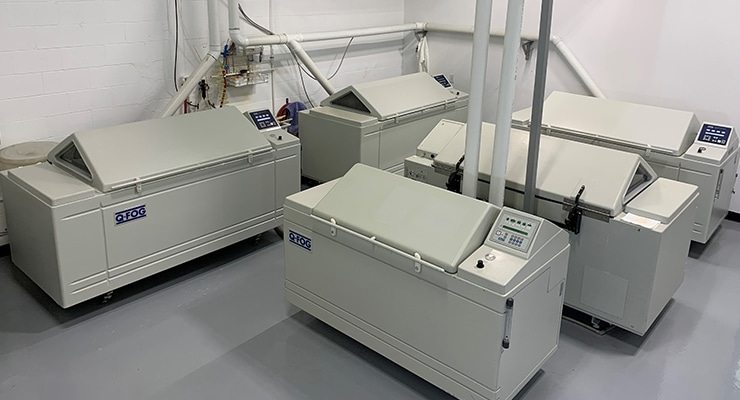ISO 9227
Corrosion tests in artificial atmospheres — Salt spray tests
ISO 9227 is a corrosion test in artificial atmospheres. It is a form of a salt spray test. ISO 9227 is particularly useful for detecting discontinuities, pores and damages in organic and inorganic coatings as well as for assessing the corrosion resistance of metallic materials. It is also a mean to determine if the comparative quality of a metallic material, either with or without corrosion protection, is preserved.
However, it is important to be aware of the fact that there is no direct correlation between resistance to the action of salt spray and resistance to corrosion as the corrosion stress in end-use conditions are significantly different than the ones during testing. In this way, results should not be used as a comparative guide to the long-term behavior of different coating systems or to rank different materials relative to each other. Micom offers ISO 9227 testing as part of its corrosion test services.

Corrosion Test Methods Using Salt Spray as per ISO 9227
There are three distinct test methods in ISO 9227: the neutral salt spray (NSS), the acetic acid salt spray (AASS), and copper-accelerated acetic acid salt spray (CASS). Typically, the NSS test applies to metals and their alloys, metallic coatings (anodic and cathodic), conversion coatings, anodic oxide coatings and organic coatings on metallic materials. As for the AASS and CASS tests, they are especially useful for testing decorative coatings made of copper, nickel and chromium or only nickel and chromium. AASS and CASS have also been found suited for testing anodic coatings on aluminum.

Experimental parameters for ISO 9227 testing
| Test method item | Neutral salt spray
(NSS) |
Acetic acid salt spray
(AASS) |
Copper-accelerated acetic acid salt spray
(CASS) |
| Temperature | 35 oC ± 2 oC | 35 oC ± 2 oC | 50 oC ± 2 oC |
| Average collection rate for a horizontal collecting area of 80 cm2 | 1,5 mL/h ± 0,5 mL/h | ||
| Concentration of sodium chloride (collected sodium) | 50 g/L ± 5 g/L | ||
| pH (collected solution) | 6,5 to 7,2 | 3,1 to 3,3 | A discrepancy has been found for the pH of this test method. Section 3.2.4 states that the pH shall be 6,5 to 7,2 while table 2 states that it shall be 3,1 to 3,3. |
| Number of test specimens | To be specified, typically 1 | ||
| Shape and size of specimens | To be specified, typically 75 x 150 mm | ||
| Arrangement of the test specimens | The specimen must be flat and placed in the cabinet facing upwards at an angle as close as possible to 20 o to the vertical. This angle shall, in all cases, be within the limits 15 o to 25 o. | ||
| Duration of tests | To be specified. Typical exposure periods are 2 h, 6 h, 24 h, 48 h, 96h, 168 h, 240 h, 480 h, 720 h, 1 000 h and 2000 h. | ||
ISO 9227 evaluation of results
Various criteria may be applied to meet particular requirements:
- Appearance after the test;
- Appearance after removing superficial corrosion products;
- Number and distribution or corrosion defects, i.e. pits, cracks, blisters, rusting or creep from scratches in the case of organic coatings, etc.; these may be assessed by methods described in ISO 8993, ISO 10289 or ISO 4628. These test methods are largely equivalent to ASTM D714 and ASTM D610.
- The time elapsing before the appearance of the first signs of corrosion;
- Change in mass;
- Alteration revealed by micrographic examination;
- Change in mechanical properties.
In ISO 9227, the Neutral salt spray test (NSS) is equivalent to ASTM B117; the same test conditions are used. However, the positions of specimens during testing must be between 15o to 25o for ISO 9227 and between 15 o to 30 o for ASTM B117. As for the Acetic acid salt spray (AASS), it is equivalent to the Acetic aide-salt spray test in annex A1 of ASTM G85. Nevertheless, the position of specimens during exposure must be between 6 and 45o for ASTM G85 while it must be between 15o to 25o for ISO 9227.
While the position of specimens changes depending on the test, studies performed in our corrosion lab on standardized reference specimens showed that sample orientation has no significant impact on the corrosion rate.
Salt Spray Testing Equipment
If you have any questions about the ISO 9227 test, we invite you to contact our material testing lab today. It will be our pleasure to answer your questions and help you with your custom testing requirements.


